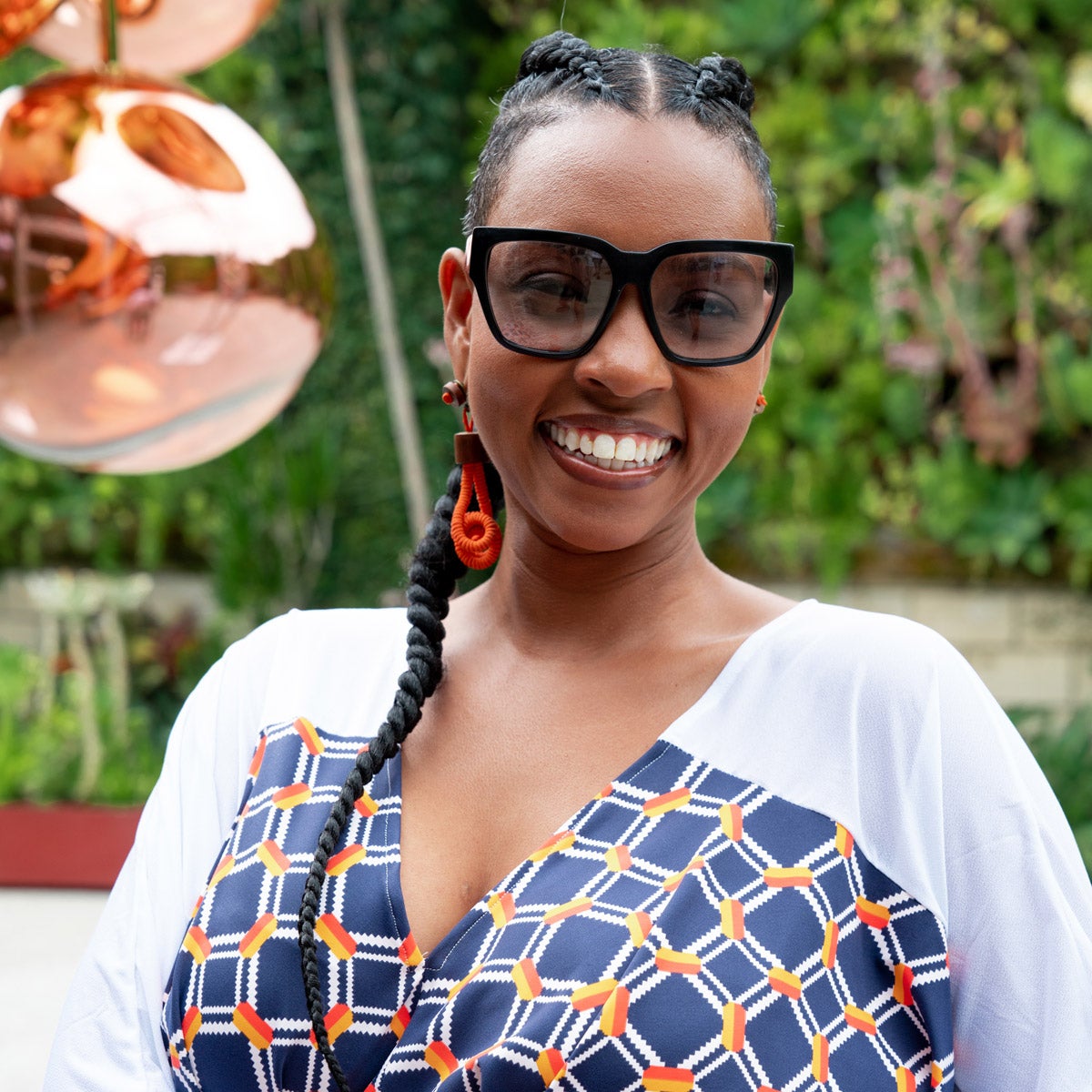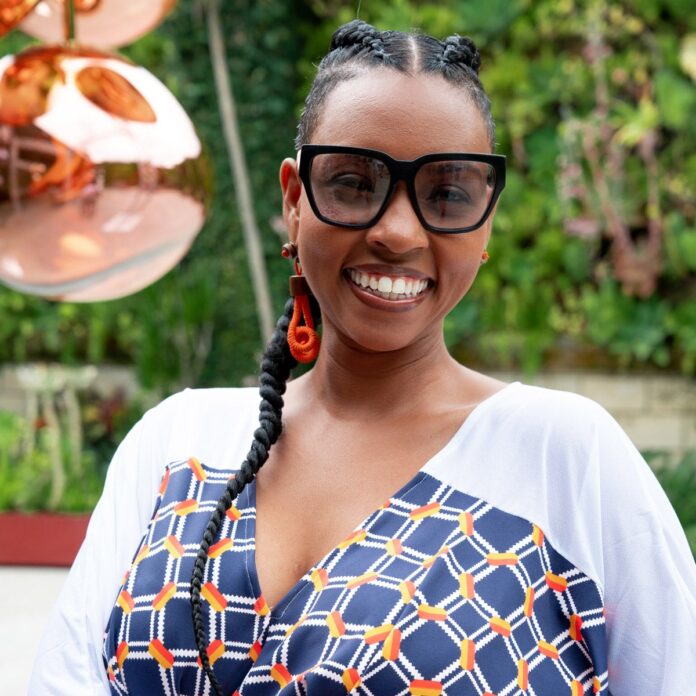[ad_1]

Educator and designer Shari Francis is constantly exploring new possibilities in the world of design. From blending textures and patterns inspired by a childhood spent between Canada and Jamaica to empowering her clients to make informed and sustainable decisions, she’s long been captivated by design’s ability to solve problems. Now a professor of interior design at Pratt Institute and founder of the Brooklyn-based studio, Dadapt, we caught up with the insatiably curious Francis to learn about blending education with her personal brand, the importance of local sourcing, the richness of materiality and more.
When or how did you first get into interior design or design in general?
I think design has always been a part of me, even if I didn’t know it. It was something as a child that I just inherently knew. If you knew me as a kid, every season my room was reconfigured, drove my parents crazy, but it was something where I was just constantly curious about how can I configure my room in ways that will make me happy, what are the possibilities. I was constantly exploring different functionalities and that’s pretty much where I started. But formally, I actually started in interior design and getting into interior design well after I graduated from college. So it wasn’t until years after I realized that the field I was in was not for me and I took continuing classes at UCLA and I realized oh wow, this has always been something that I loved.
What is your idea of good design? What is your goal when working on a project or with a client?
In terms of good design for me, it really starts at the root of the issue and solving the problem in the best possible manner. So even before we look at aesthetics, it’s how does it function and can we find the solution that makes sense before we even fully investigate the aesthetics. I think understanding and investigating various aesthetics, various precedents, and understanding how that can be incorporated into a client’s style is important. But I would definitely say solving the problem and making sure that it is fully solved is the way to good design.
As for my goal when working with a client, there are several goals that I have. One of the main goals is to educate them on how to create a cohesive narrative, how things can function for them even if they didn’t understand what that is, and to educate them in letting them know where their money is going. Design can involve a lot of money, so it’s important for clients to understand where they’re investing in durability versus things that may need to be changed over time. At the end of the day, my hope is that when I design, it is for more longevity instead of just fast design. I strive for sustainability and durability while considering various financial needs. And of course, my ultimate goal is to make sure the client is happy.
Do you have a specific design style or aesthetic, and how would you describe it?
I aspire to simplicity and intentionality in my designs. Whether it’s incorporating crisp, adjacent lines or smooth elements, I aim to create intentional design. However, everything is generally bespoke and depends on the client. In terms of my education as a designer, there are still a lot of influences based on European values, but I’m exploring new ways and trying to incorporate my past, history and culture into something new. I draw inspiration from my experiences growing up in Canada and spending time in Jamaica, appreciating the beauty of natural materials and textures. I’m exploring how to synthesize these influences and incorporate them into interior design using natural materials and intriguing patterns. Overall, my style is an ongoing exploration, and I’m constantly investigating and discovering new ways to create unique designs.
What kind of inspirations are you pulling from in your research?
When I look at the past, I do have quite a juxtaposition between growing up in Canada and spending time in Jamaica. The dualities I’m finding there are how nature is really important, and the beauty of what natural materials can do and how they make you feel.
In Canada, there was a lot of brickwork due to the climate, while Jamaica had a lot of stucco and clay work which I’m trying to find, and I was thinking: Oh well those similarities would really be cool, trying to create something interior wise. How could I do that?
Growing up and seeing a lot of the plaid and checkered patterns versus the weaving that I’ve seen in and around my grandparents’ town, those are things that I’m starting to see and think about. How can I synthesize these things—my grandmother constantly crocheting—and how can I bring that in? Does it mean that I can change my philosophy? Or is it still the same as “simplicity as more”? How can I incorporate all of these things—through using other natural materials? How can I take some of these really interesting patterns that may have been used or created through wool, or rattan and jute—what can that do?
Right now, I’m in an exploration phase of “this can work.” It’s a lot of material and it sounds like it is a lot of material. I think the basis of understanding interior architecture is how you apply the materials to create that experience—that’s highly important. I think that allows you to stand out from the rest, or it allows you to have a certain following that appreciates how you are designing or how you’re studying or how you are investigating your process or just design in itself. My hope is that I will understand this investigation sooner rather than later.
At the moment, in the investigation of renovating my home, what I’ve realized is there are some things I can do and some I can’t because of budget constraints, but that doesn’t stop me from putting things in my notebook. Even having conversations with other designers and makers, like, is this even possible? It gets the wheels turning.
What does being an innovator or being on the Innovators Council mean to you, and how has being on the Innovators Council made an impact on you?
For me, being on the Innovators Council has made me realize and appreciate the diversity of thought within the design field. It’s fascinating to see how the word “design” or “interior design” can be interpreted and applied in so many different ways. Each of the innovators on the council uses design in their own unique manner, whether it’s in their business, lifestyle, education, or how they present it to the world. Being part of this council has allowed me to learn about these different aspects and break away from the traditional ways interior design is taught in school. It has created a community that I may not have otherwise known, where I can interact with other innovators and gain insights into their approaches to design, whether it’s in social media or other avenues. This community is supportive yet individualistic, and I truly appreciate that.
I heard Alvin Wayne dropped into your classroom at one point. Can you tell us about that experience?
Yes, I can’t forget that Alvin was so gracious to give us his time. He provided valuable feedback to my students, being both positive and constructive in his criticism. It was a great opportunity to have him as a guest in my classroom. Being on the Innovators Council has not only allowed me to create friendships but also provided me with a network of design professionals who can act as a sounding board for ideas and offer unique perspectives. It’s been a valuable experience to have them come into my world and provide their take on design to my students.
What advice would you give designers?
If I were to give advice to designers starting their own business, I would emphasize the importance of building a strong network or creating their own design community even before they start. While designers inherently know how to design and what attracts them, the biggest challenge lies in having the necessary support once they secure a project. Having a reliable network of architects, contractors, drafters, or other professionals in place before starting any project can make the process much smoother and increase the likelihood of success. Additionally, I would advise my younger self to explore design earlier in life, as design is not something that offers instant gratification. If you have a passion for design, don’t wait and pursue it as early as possible.
What are your keys to a successful design project?
An amazing team is one of the key factors for a successful design project. Design is not a singular effort, and having a talented and collaborative design team, as well as a supportive design community, plays a crucial role in achieving success. Other than that, I always strive to source products locally whenever possible. While exceptional products can be found in other countries, I aim to prioritize local sourcing to support local businesses and minimize the environmental impact of shipping. Educating clients about the importance of sourcing locally and considering sustainability is also an integral part of my approach.
How do you incorporate your personal brand into your work?
Currently, my personal brand revolves around education. I bring my educational background and expertise into my projects, empowering clients with knowledge and helping them make informed decisions. While I’m still working on further developing my personal brand, I look up to professionals like Alvin [Wayne] and Anne [Sage] who have successfully communicated their personal brand to the world. For now, education remains a significant aspect of my personal brand.
How do you like to source products for your projects?
I generally prefer to source products locally or make them locally if possible. That’s one of my main priorities, and I’ve had success with it. However, there are amazing things in other countries that sometimes need to be obtained. So, it’s a mix. But if I can get the building materials and finishes locally, I feel like I’m winning and being more sustainable. As designers, even though we talk about sustainability, we’re not really sustainable when it comes to shipping things and contributing to the carbon footprint. So, if I can personally go to the store or the vendor, like the D&D building, and pick things up, I try to do that. I also educate myself on whether things are made in America and the travel distance involved in getting them to the project. When working on international projects, I also consider sourcing locally from those countries. So, sourcing products locally is a major factor for me.
Is there a specific piece of furniture or lighting that you must have in any project?
I can’t recall the name at the moment, but I always have these open-faced lights with Edison light bulbs. They are simple and don’t have any shades. Looking back at my projects, I realize I consistently incorporate simple pendant lights or similar lighting without extravagant designs. These lights serve as the main source of light in the space.
How does community fit into design?
Community is integral to design. It encompasses the design community itself, the community I grew up in, and the experiences of individuals within the community. Whether they’re designers, makers, artists, family, or friends, every aspect of the community and their movement and experiences are incorporated into design. For example, my family experiences, such as my mother inspiring me and my grandmother’s knitting and crocheting, have influenced my work. So, community plays a significant role in my designs.
The post Shari Francis on Discovering the Undiscovered Through Design first appeared on The Edit | Lumens.com.
[ad_2]
www.lumens.com










